Imagine stepping into your backyard and finding a space that’s not just visually stunning but also incredibly versatile. Whether you’re just starting to explore the world of outdoor design or you’re a seasoned pro, “14 Multi-Purpose Outdoor Areas Ideas for Your Next Project” offers a treasure trove of inspiration to transform your outdoor areas into functional, beautiful retreats. This guide is your gateway to discovering how strategic design can turn your outdoor dreams into reality.
From cozy fire pits that double as alfresco dining spots to garden nooks perfect for meditation and entertaining, each idea in this guide is crafted to enhance your outdoor living experience. With practical tips and creative solutions, you’ll soon see how adaptable and rewarding your outdoor space can be. Let’s dive in and unlock the potential of your backyard, making it a true extension of your home where memories are made and relaxation is guaranteed.
Incorporate Convertible Furniture Options
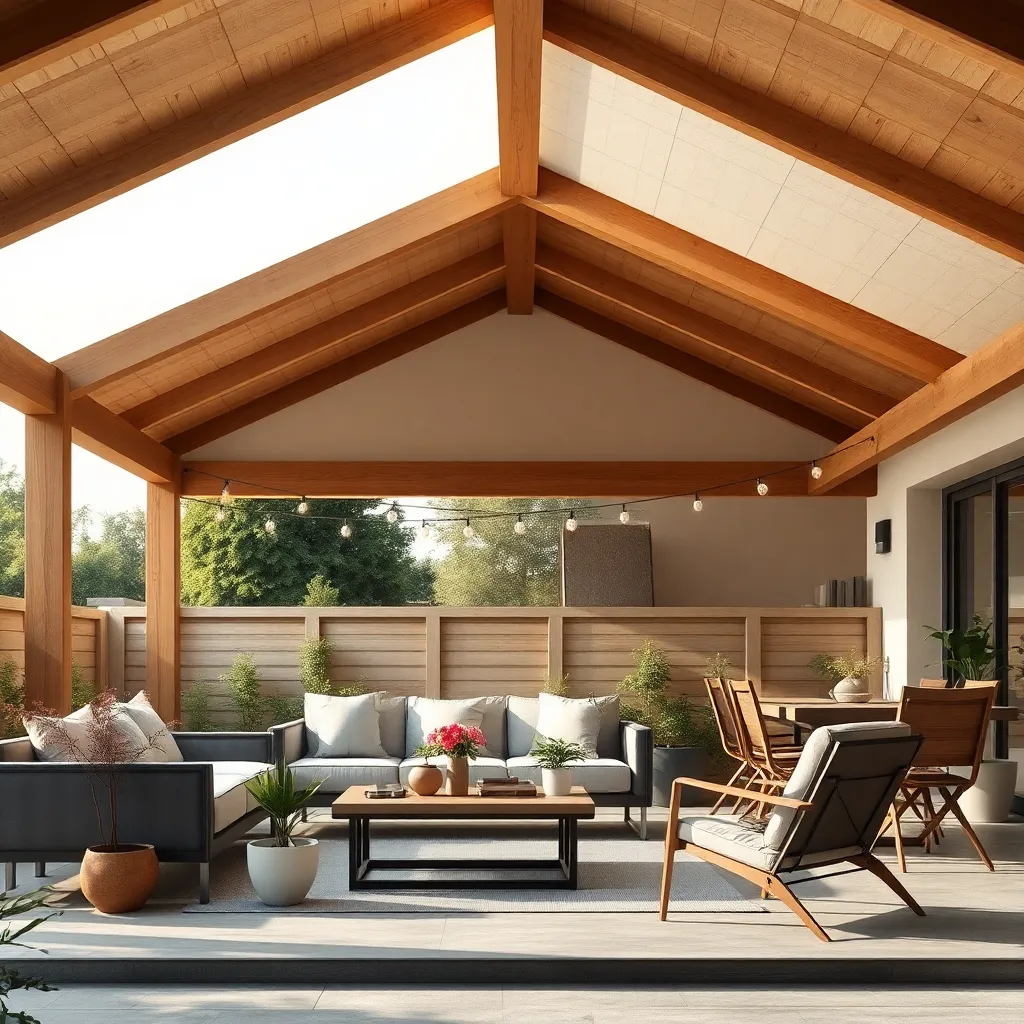
Incorporating convertible furniture into your outdoor shelter can provide flexibility and maximize space. Start with pieces like a folding dining table or benches that can double as storage units. Look for weather-resistant materials like teak, aluminum, or high-density polyethylene to ensure durability against the elements. For beginners, consider simple pieces that are easy to fold and store, while more advanced DIYers might explore creating custom-built multifunctional furniture to suit specific needs.
Think about how your outdoor space is used and choose convertible furniture that can adapt to various activities, such as lounging, dining, or entertaining. Modular seating arrangements are excellent for adapting to different group sizes, and adjustable lounge chairs can transition from sunbathing to dining with ease. Advanced enthusiasts might experiment with built-in convertible features, like a bench that transforms into a daybed, utilizing hydraulic systems or hidden hinges for a seamless transformation. Prioritize comfort and practicality to ensure your outdoor area is as inviting as it is functional.
Utilize Versatile Pergola Structures
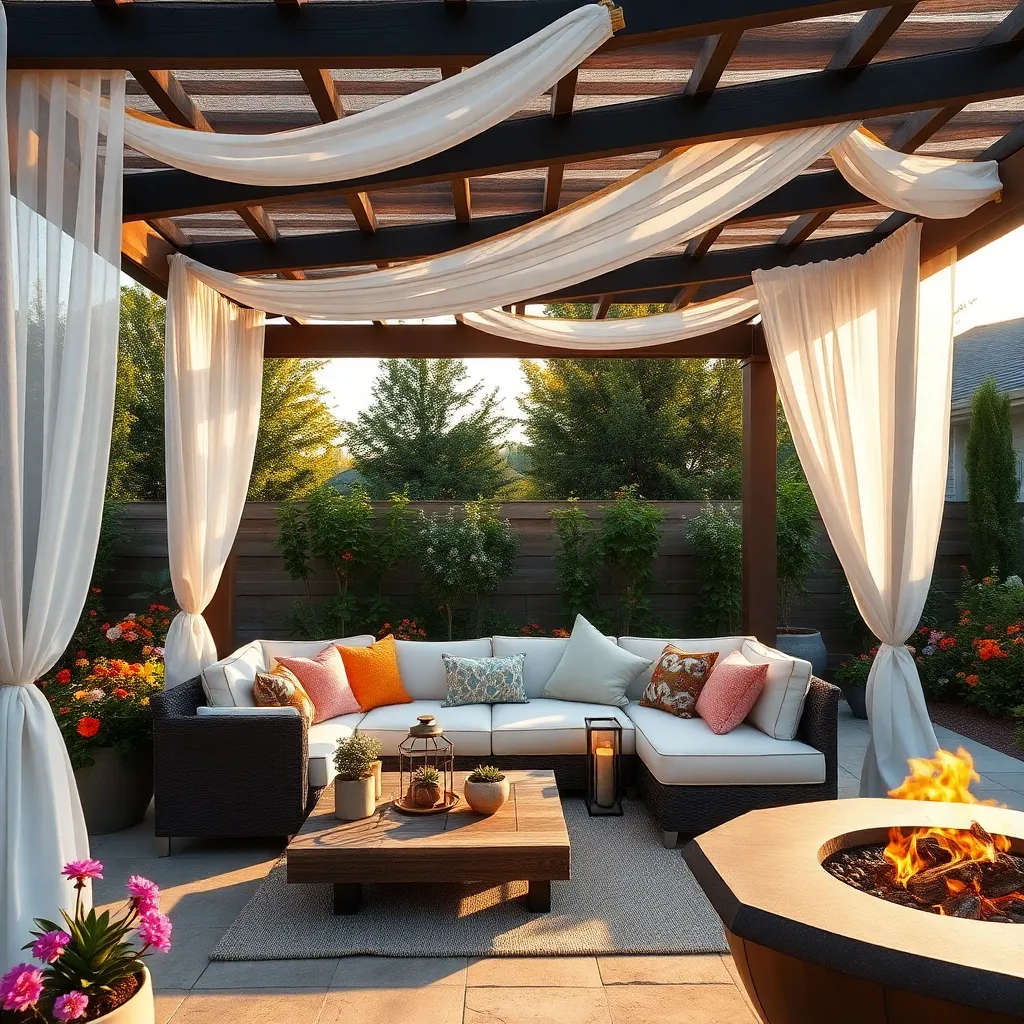
Transform your outdoor space by installing a pergola, a versatile structure that provides both shade and style. For beginners, consider using pressure-treated wood or aluminum for durability and ease of maintenance. These materials are ideal for creating a structure that requires minimal upkeep while still offering a classic look. By adding a retractable canopy or climbing plants like wisteria or grapevines, you can further enhance the aesthetic and functionality, creating a comfortable retreat from the sun.
For those ready to take on more complex projects, integrate additional features like built-in lighting or a louvered roof that can be adjusted to control sunlight and ventilation. Advanced designs may include custom dimensions to fit your specific space, ensuring the pergola becomes an integral part of your landscape. Opt for composite materials or steel for a modern touch and increased longevity. Whether your goal is to create a cozy nook or a grand entertainment area, a pergola is a flexible solution that can evolve with your needs.
Design With Retractable Awning Systems
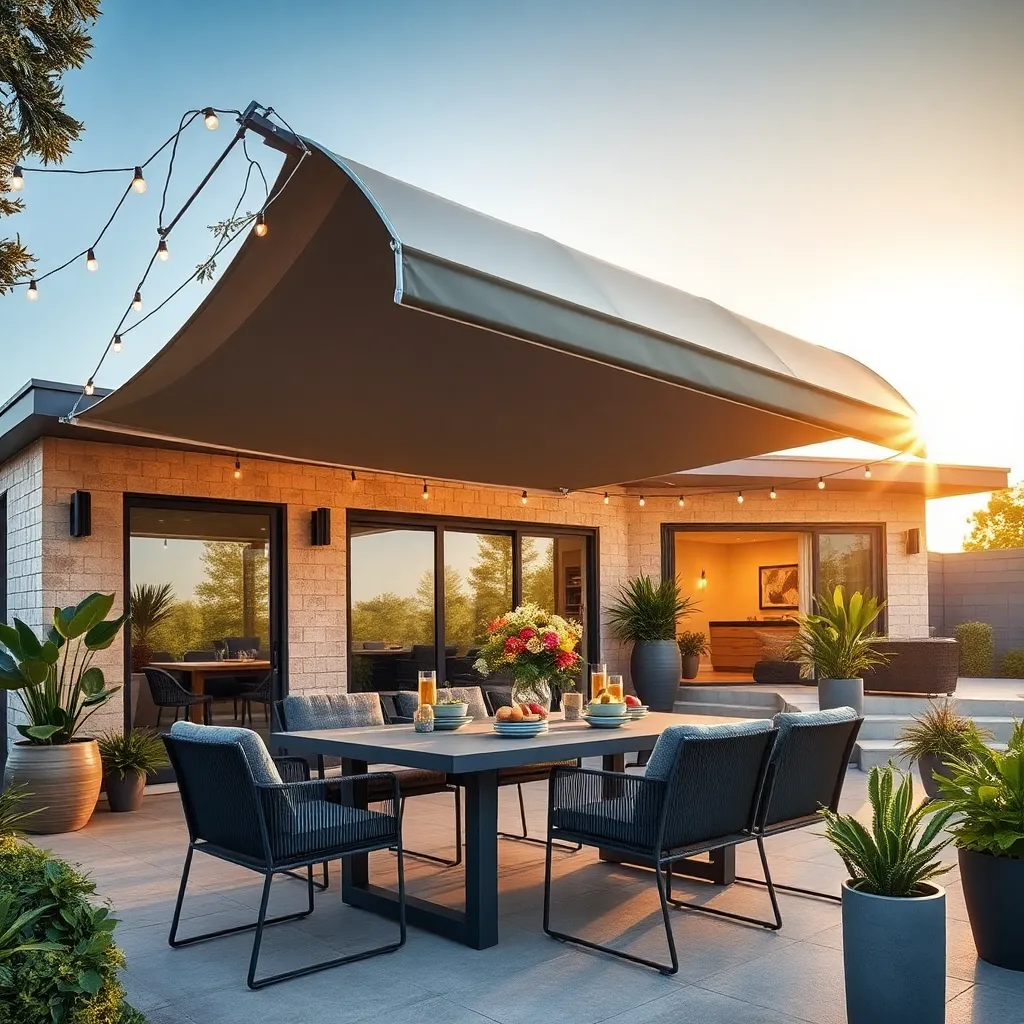
Retractable awning systems offer a flexible solution for outdoor areas by providing shade when needed and retracting to let in sunlight when desired. Choose materials that are durable and weather-resistant, such as aluminum frames and high-quality, UV-protected fabric, to ensure longevity. Beginners can start with a simple manual retractable awning, while those looking for a more advanced setup can explore motorized options with remote controls or smart home integration.
When designing with retractable awnings, consider the size of the area you wish to cover to ensure adequate protection and aesthetic balance. Measure your space carefully and consult with a professional if needed to ensure the awning fits seamlessly with your existing outdoor setup. For added functionality, select awnings with adjustable pitch to control rain run-off and enhance shade at different times of the day. With thoughtful planning and the right materials, retractable awnings can transform your outdoor space into a comfortable, versatile haven.
Create Flexible Seating Arrangements

To create flexible seating arrangements, consider using modular furniture that can be easily reconfigured to suit different occasions. Look for weather-resistant materials like teak or powder-coated aluminum, which offer durability and low maintenance. For beginners, simple options like stackable chairs or folding tables provide versatility without the need for complex planning.
For those wanting a more advanced setup, invest in sectional sofas with interchangeable pieces that allow for customization. Add cushions with removable, washable covers in outdoor-friendly fabrics such as Sunbrella for both comfort and convenience. Consider incorporating multi-level seating with built-in benches or raised platforms to maximize space and functionality. Such designs encourage social interaction and can adapt to both intimate gatherings and larger events.
Add Multi-Functional Storage Solutions
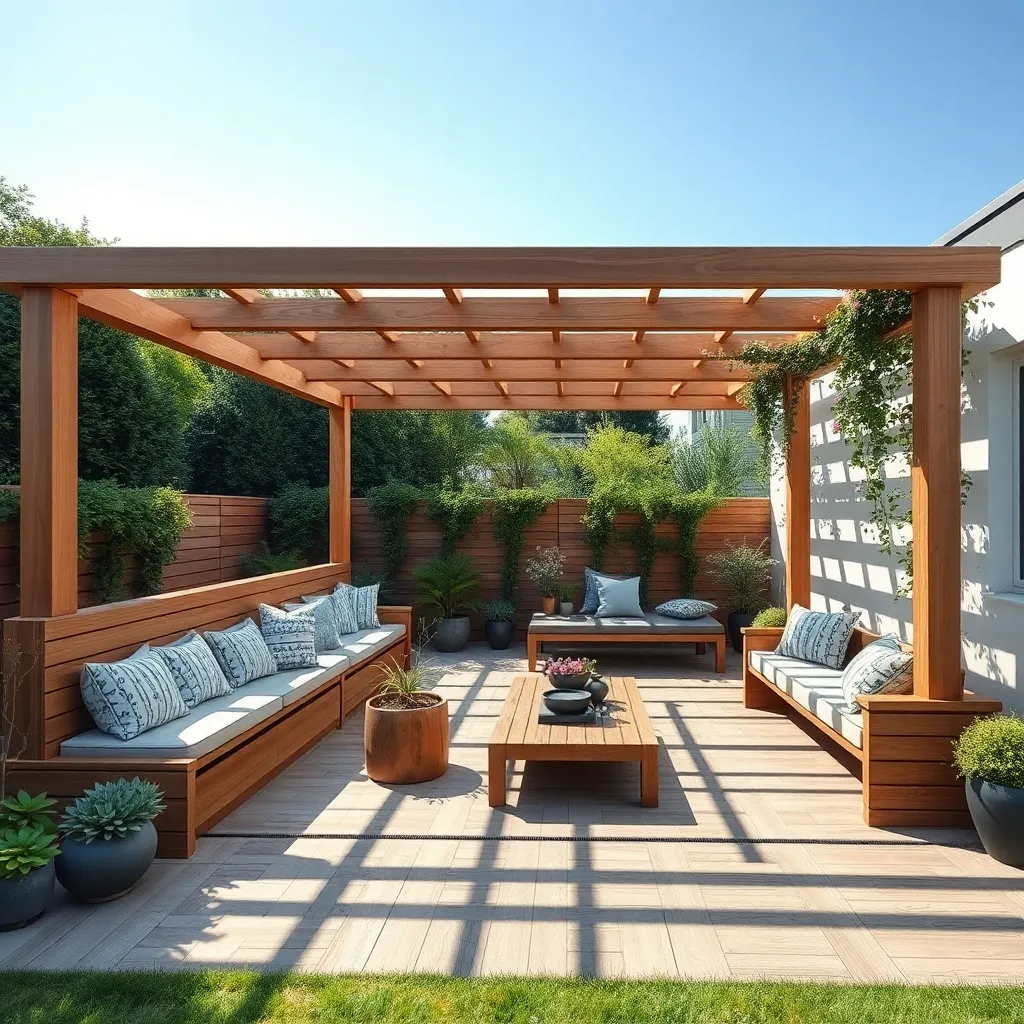
Maximize your outdoor space by incorporating multi-functional storage solutions that blend seamlessly with your environment. Consider using weather-resistant materials like teak, cedar, or powder-coated metal for durability and aesthetic appeal. For a basic approach, opt for a storage bench that doubles as seating. This is perfect for stowing away gardening tools or outdoor cushions, keeping everything neat and within reach.
For those looking to elevate their design, integrate built-in storage units within your outdoor shelter. You might install shelving or cabinetry along the interior walls, providing ample space for both functional items and decorative elements. Advanced tip: Use modular storage systems that can be reconfigured to suit changing needs or seasonal items. Don’t forget to add features like adjustable shelves and hidden compartments to enhance utility and maintain a clutter-free area.
Include All-Weather Cooking Stations
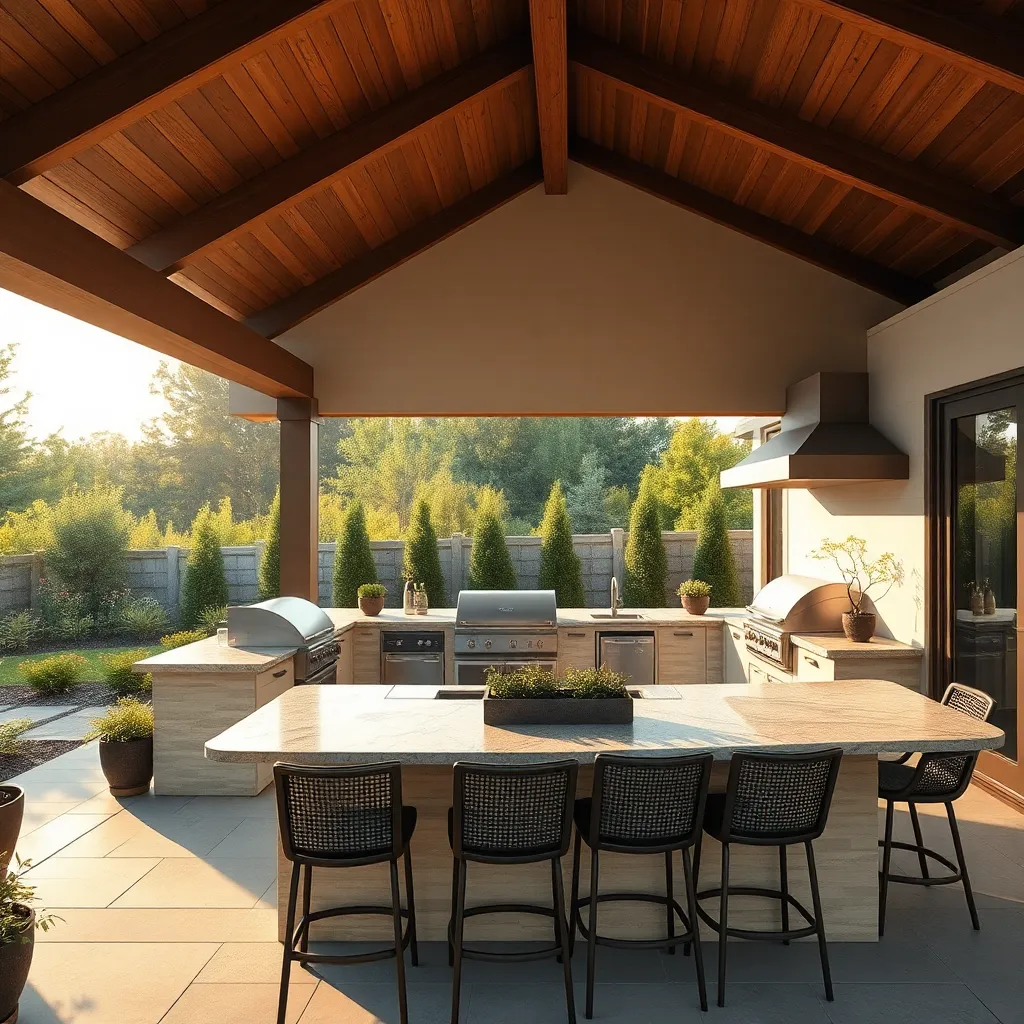
Transform your backyard into a culinary paradise by incorporating an all-weather cooking station. Start with a durable foundation using materials like concrete or weather-resistant wood to withstand the elements. Adding a roof or pergola with a retractable canopy provides protection from rain and sun, allowing you to cook comfortably year-round. For beginners, a basic setup with a grill, prep area, and storage for utensils is a great start, while seasoned outdoor chefs might consider a built-in pizza oven or smoker for more advanced cooking options.
Ensure your cooking station is both functional and stylish by selecting materials that complement your outdoor décor. Opt for stainless steel appliances for their durability and ease of maintenance, and use natural stone or tile countertops that can handle high temperatures and are easy to clean. Lighting is crucial, so incorporate LED fixtures to illuminate your workspace during evening gatherings. For those looking to enhance their setup, consider adding a small sink with a water connection or a mini-fridge for convenience. Remember, thoughtful planning and design can turn your outdoor shelter into a versatile and inviting cooking haven.
Install Customizable Shade Sails
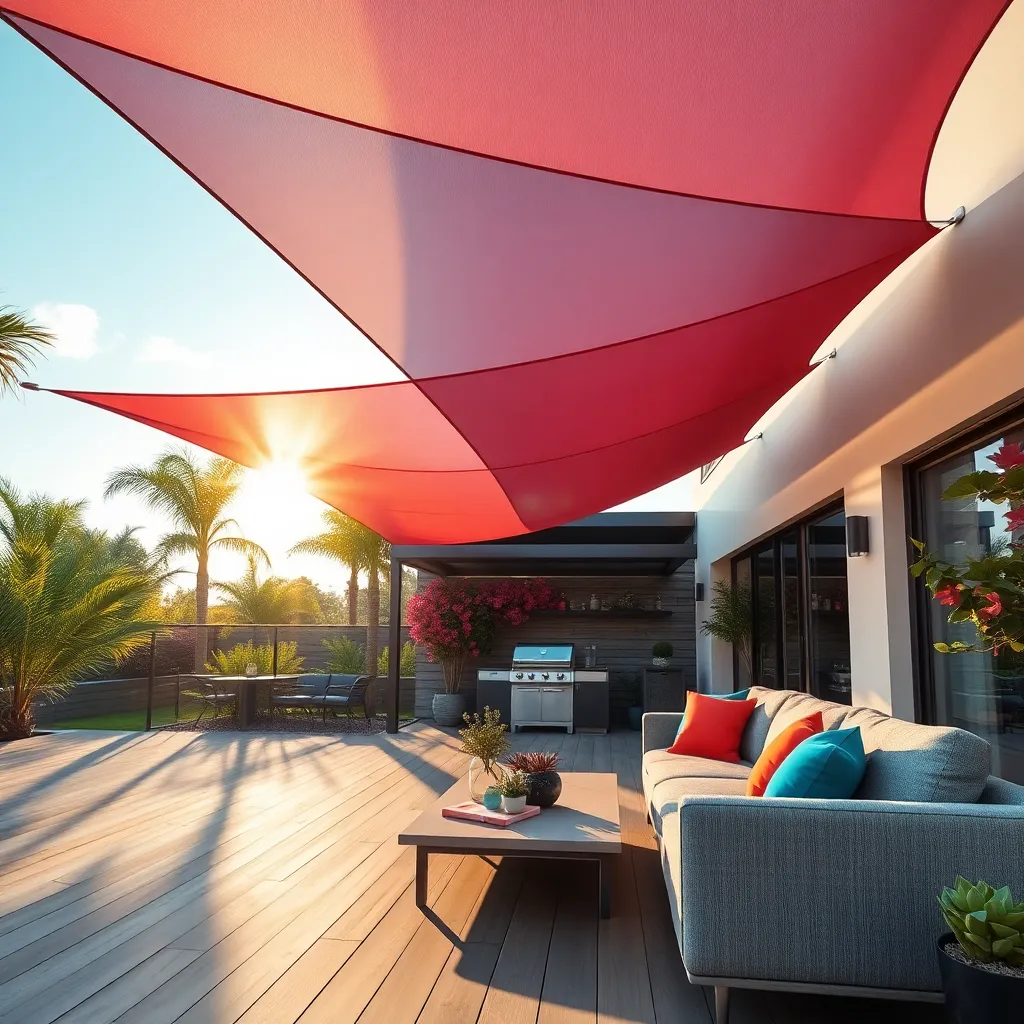
Customizable shade sails are a versatile addition to any outdoor space, providing both style and function. Start by selecting a durable, UV-resistant fabric—such as high-density polyethylene—to ensure longevity and effective sun protection. Measure your area accurately to determine the number of sails needed and the best configuration for optimal coverage; this is crucial for achieving a tailored look that fits your space perfectly.
When installing shade sails, consider using stainless steel hardware for durability and resistance to the elements. Position the sails at varying heights to create visual interest and improve airflow beneath the structure. For a more advanced touch, incorporate adjustable tensioning systems to easily modify the sails’ positions as the sun shifts throughout the day. This setup not only enhances comfort but also adds a dynamic architectural feature to your garden or patio.
Implement Portable Fire Pit Areas
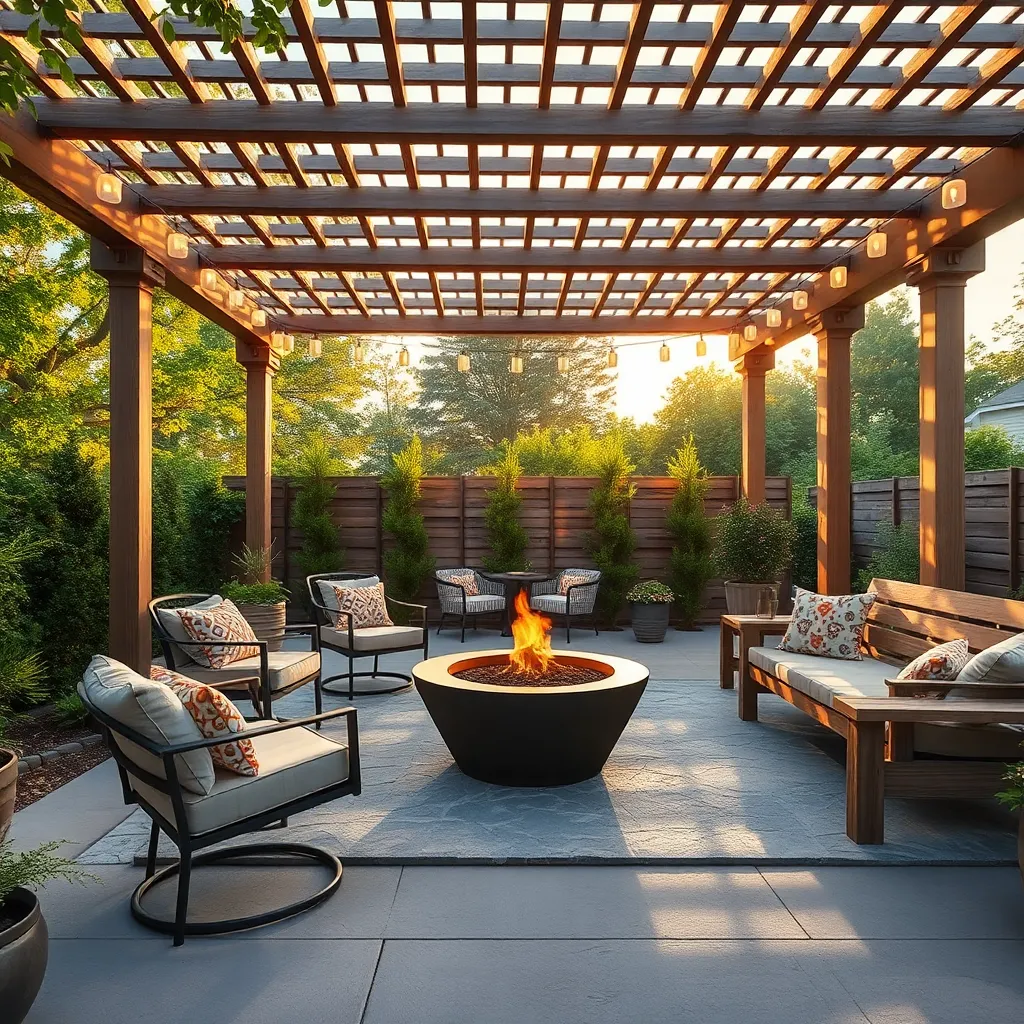
Creating a portable fire pit area is an excellent way to add warmth and ambiance to your outdoor space, making it multi-functional and inviting. Choose a lightweight, durable fire pit made from materials like cast iron or stainless steel for easy mobility. Position your fire pit on a non-flammable surface such as stone pavers or gravel to ensure safety and stability. Arrange comfortable seating, like weather-resistant chairs or benches, in a semi-circle around the pit to encourage conversation and relaxation.
For a more advanced setup, consider incorporating multi-level decking to define the fire pit area and add visual interest. Use composite decking materials for low maintenance and longevity. Integrate elements like built-in storage for firewood or a small table for drinks to enhance functionality. Consider adding string lights or solar-powered lanterns around the area to create a cozy atmosphere that can be enjoyed both day and night. Always check local regulations regarding open fires in residential areas to ensure compliance and safety.
Select Dual-Purpose Planters and Dividers
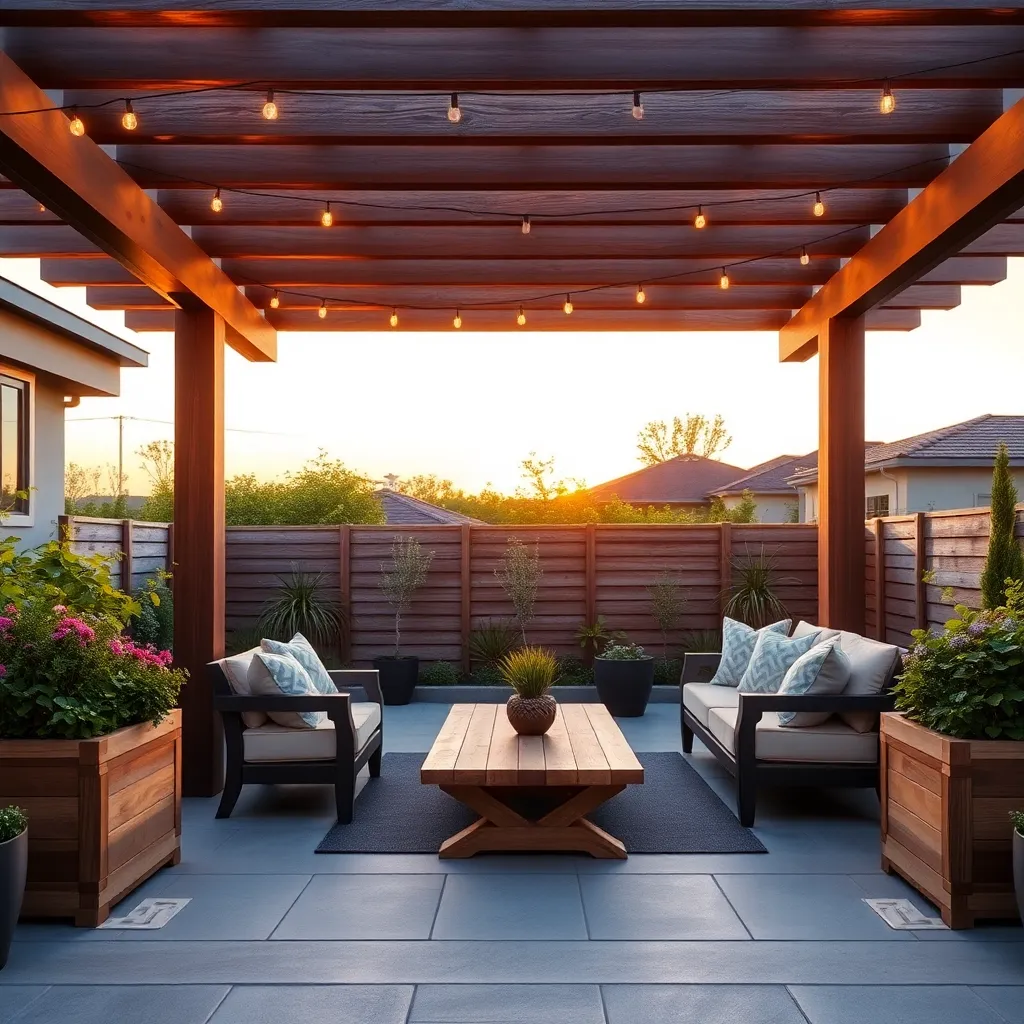
Transform your outdoor space by selecting dual-purpose planters and dividers that both beautify and structure your area. Start with sturdy materials like concrete, wood, or metal to ensure durability and weather resistance. For beginners, consider modular planters that can be easily rearranged to suit your evolving needs. This allows you to experiment with different layouts and plant combinations without committing to a permanent structure.
For those looking to enhance their design, incorporate vertical planters that also serve as privacy screens. Use climbing plants such as ivy or jasmine for a lush, natural barrier. Advanced gardeners might explore custom-built options, blending built-in seating or integrated lighting into the planter design. Remember, dimensions matter: aim for planters at least 24 inches deep to accommodate a variety of plant roots, ensuring your green dividers thrive throughout the seasons.
Integrate Mobile Outdoor Bar Carts
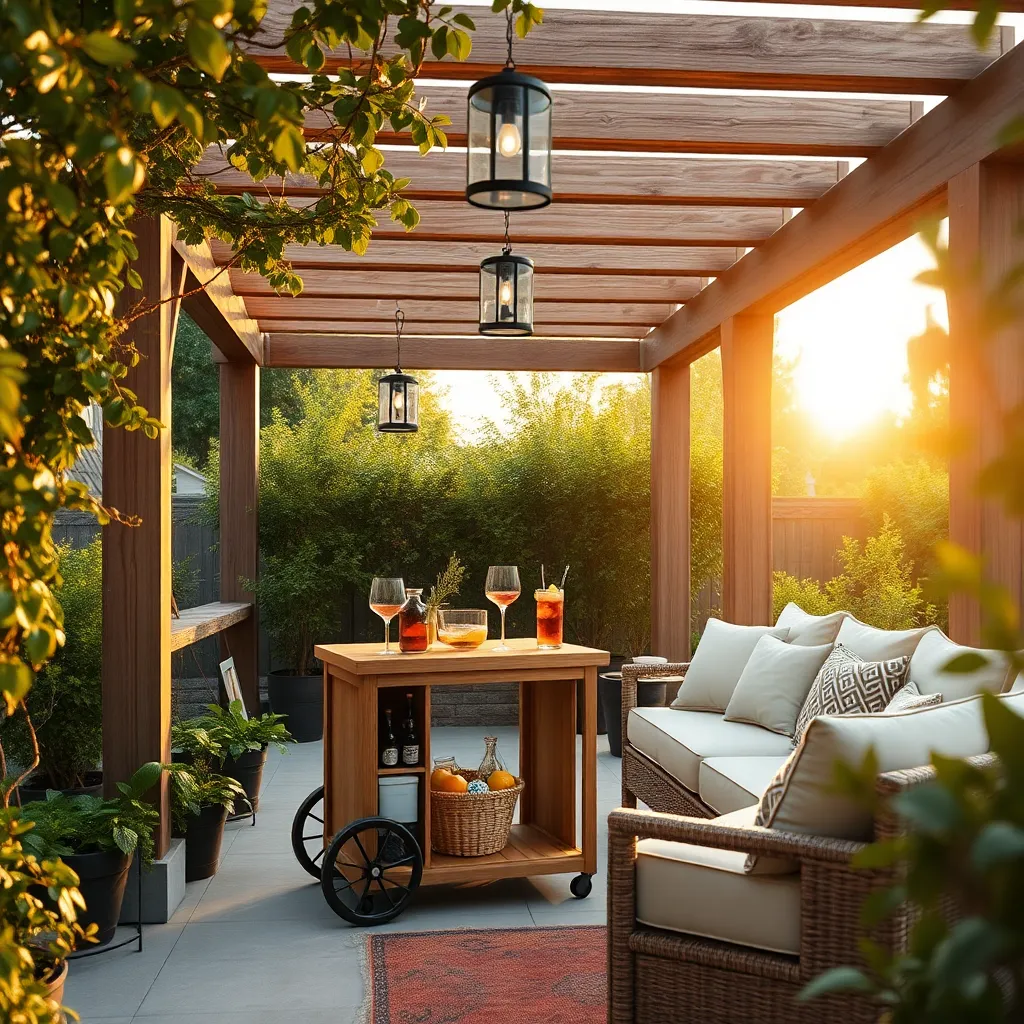
Adding a mobile outdoor bar cart to your outdoor area is a simple yet effective way to enhance functionality and entertainment options. Choose a cart made from weather-resistant materials like teak, powder-coated aluminum, or stainless steel to ensure durability. For beginners, look for designs with lockable wheels for stability and easy maneuverability across different surfaces. A bar cart with multiple shelves can accommodate a variety of beverages, glassware, and even a small ice bucket, making it a versatile addition to any gathering.
Advanced DIY enthusiasts might consider customizing their bar cart with built-in features such as a cutting board surface or integrated bottle openers. Incorporate elements like detachable trays or foldable side tables to maximize utility and space efficiency. When selecting a cart, aim for dimensions that fit comfortably in your outdoor area, typically around 30 to 40 inches in width and 18 to 24 inches in depth. This approach not only enhances your outdoor entertainment space but also adds a touch of personal style and convenience.
Use Modular Decking Systems
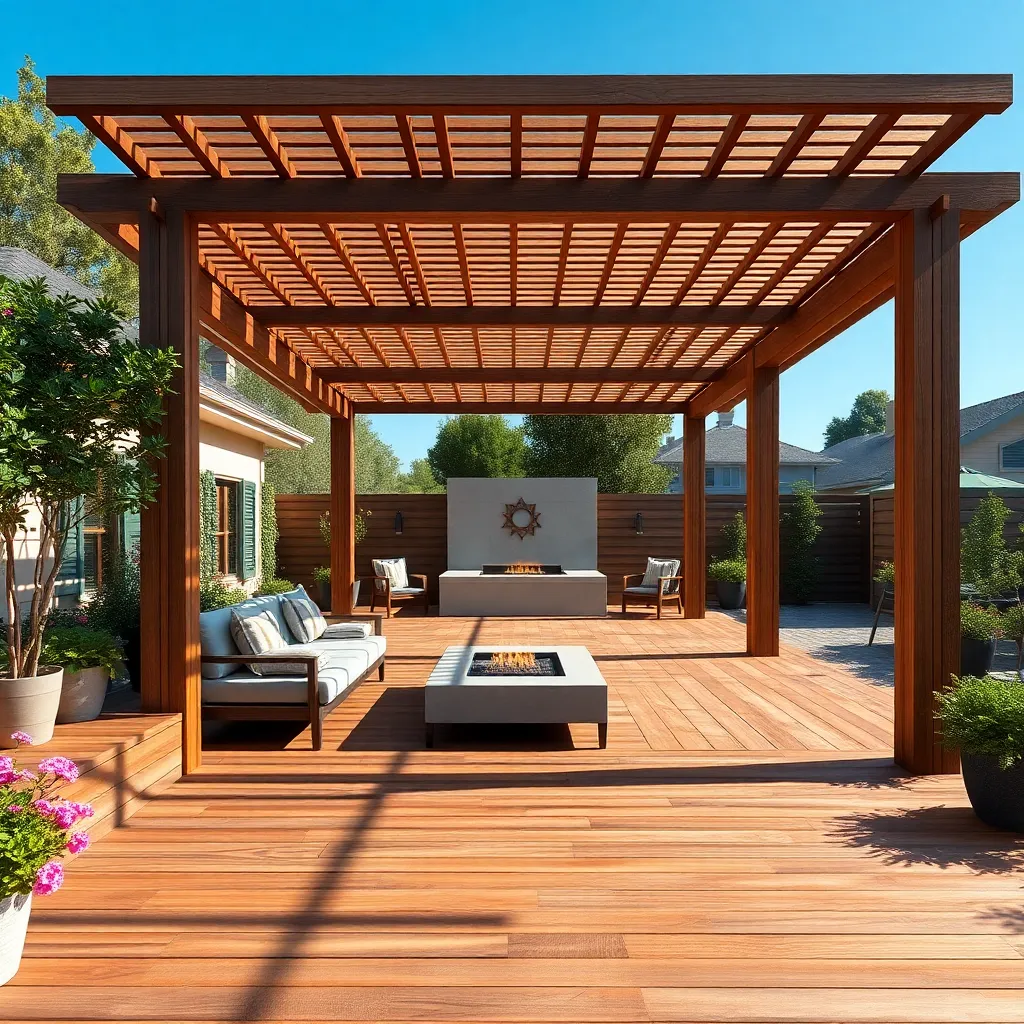
Consider using modular decking systems to quickly transform your outdoor area into a versatile space. These systems offer easy installation with interlocking tiles that can be set up without professional help, making them perfect for DIY enthusiasts. Choose from materials like wood, composite, or even eco-friendly options like recycled plastic, depending on your climate and aesthetic preferences. With modular decking, you can customize the size and shape to fit your specific area, whether you’re creating a cozy corner or a large entertaining space.
For those with more experience, consider integrating features such as built-in seating or planters to enhance functionality. Elevate your design by incorporating various levels, which can add depth and interest to your outdoor area. Ensure to allocate space for drainage and consider weather-resistant finishes to prolong the life of your decking. By planning carefully, you can create a multi-purpose area that accommodates everything from relaxing afternoons to lively gatherings, all while boosting the value and enjoyment of your home.
Combine Built-In and Movable Seating
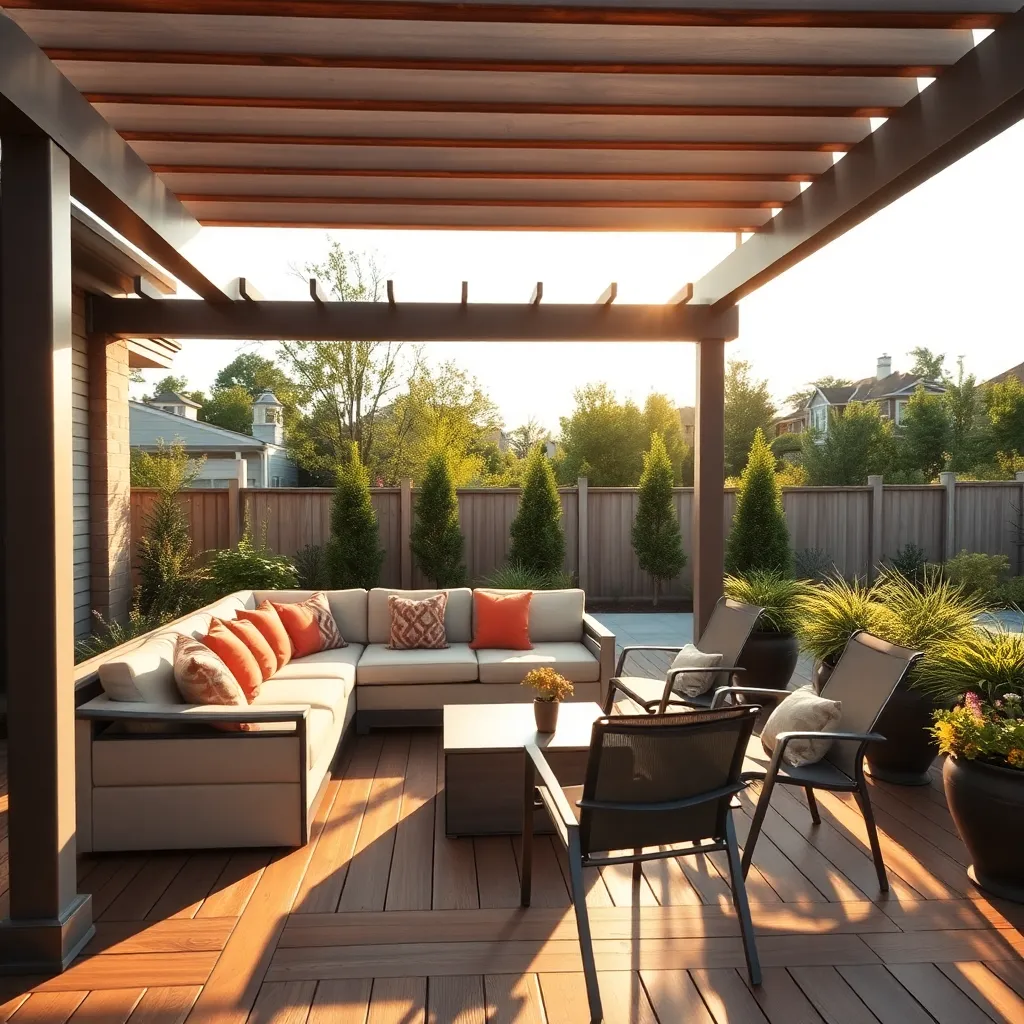
Combining built-in and movable seating in your outdoor shelter can maximize both function and flexibility. Consider crafting built-in benches along the edges of your patio using durable materials like cedar or treated pine, which are resistant to weathering. For a versatile approach, complement these fixed elements with movable pieces such as lightweight rattan or metal chairs. This allows you to easily rearrange the space for various occasions, from intimate gatherings to larger parties.
For those looking to add a personal touch, consider cushions and upholstery in weather-resistant fabrics to enhance comfort and style. Choose colors and patterns that complement your outdoor aesthetic while ensuring they can withstand UV exposure. For a more advanced touch, integrate storage compartments into your built-in seating to keep outdoor essentials like blankets or cushions neatly tucked away yet easily accessible. This combination not only optimizes seating options but also adds a layer of practicality to your outdoor oasis.
Plan for Seasonal Plant Variations
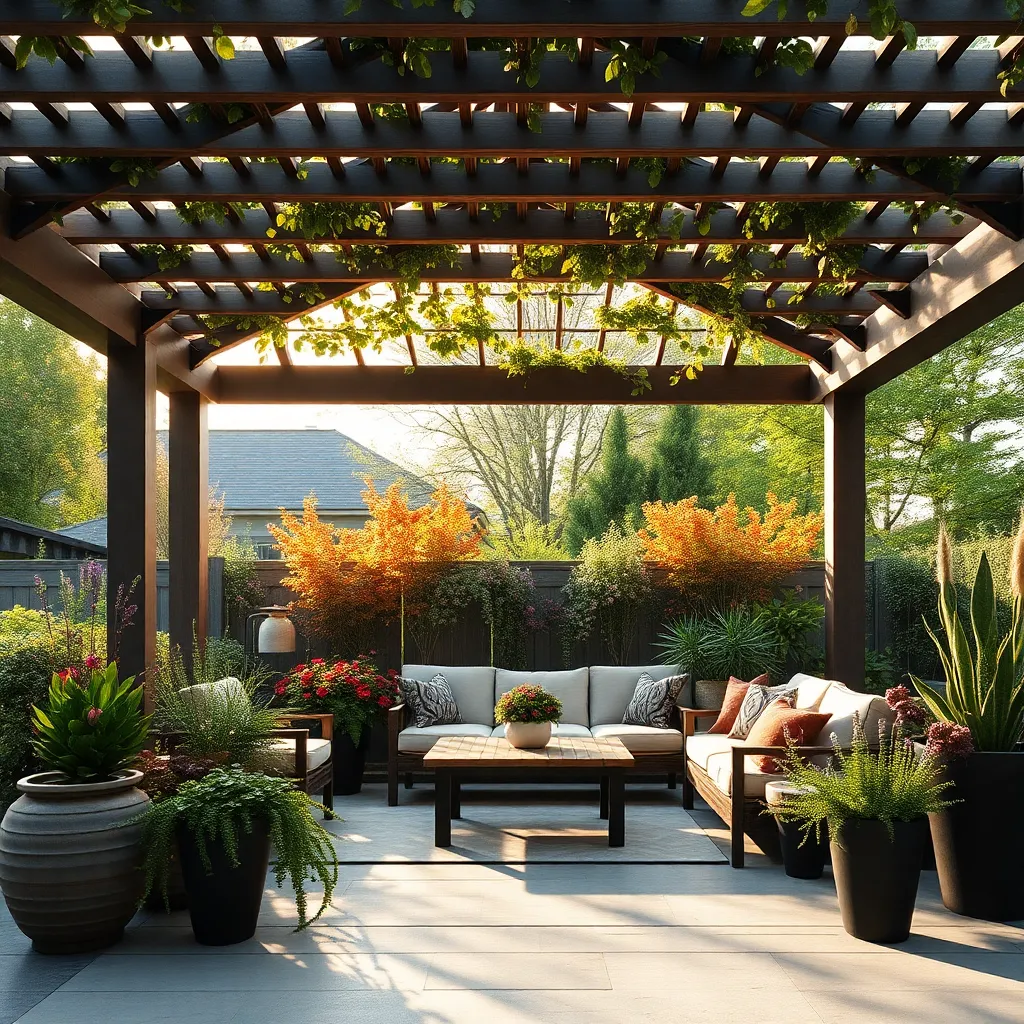
When planning your outdoor shelter, it’s crucial to consider how seasonal plant variations will affect the space. Opt for a design that accommodates both summer blooms and winter dormancy. Materials like pressure-treated wood or weather-resistant metals ensure longevity through seasonal changes. For beginners, start with simple structures like a pergola or gazebo that can support climbing plants. Advanced gardeners might integrate retractable canopies or adjustable louvered roofs to allow for varied sunlight exposure and protection against harsh weather.
Integrating seasonal plant variations enhances both aesthetics and functionality. Use potted plants for flexibility, allowing you to swap out species as the seasons change. Consider designing built-in planters with drainage systems, ensuring plants thrive year-round. Additionally, consider insulation for colder months with thermal curtains or windbreaks, maintaining a cozy environment. For those eager to experiment, try using smart irrigation systems that adapt to seasonal water needs, keeping your plants healthy and vibrant.
Design Interactive Play and Relax Zones
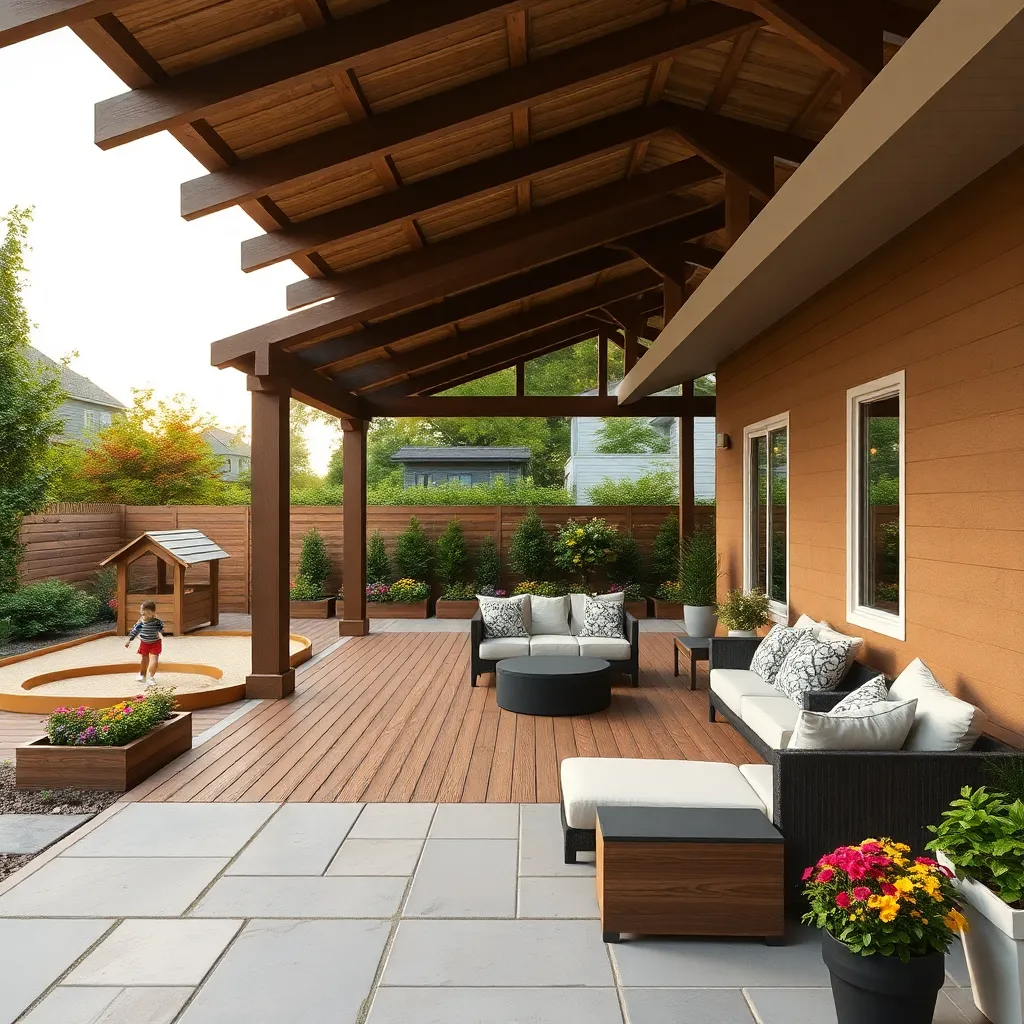
Creating interactive play and relax zones in your outdoor area can transform your garden into a multifunctional paradise. Start by incorporating a mix of materials like weather-resistant wood and durable outdoor fabrics to construct comfortable seating areas. Consider a pergola with climbing plants for shade, or a simple tarp for budget-friendly coverage. Incorporate playful elements such as a small sandbox or a vertical garden wall for visual appeal and engagement.
To enhance the functionality of these zones, use modular furniture that can be easily rearranged. Opt for lightweight and stackable pieces for flexibility. For a more advanced touch, install outdoor lighting that can be adjusted for different activities, like spotlighting for games or soft lighting for relaxation. Remember, the key to a successful outdoor space is adaptability, allowing it to evolve with your family’s needs.
Conclusion: Creating Beautiful Outdoor Spaces
As we explored the 14 multi-purpose outdoor area ideas, each concept highlighted the importance of versatility, communication, shared experiences, and personal space in nurturing strong relationships. From creating tranquil garden nooks for intimate conversations to designing playful backyard setups that spark joy and laughter, these ideas serve as a blueprint for fostering connection and harmony in your personal life. Whether it’s through a cozy fire pit for evening chats or a communal dining area that encourages family gatherings, each suggestion emphasizes the value of cultivating environments that support togetherness and mutual growth.
Now, take the first step by selecting one idea that resonates with you and start planning how you can bring it to life. Gather your loved ones, share this vision, and let the magic of collaboration enhance your relationships.
Don’t forget to save or bookmark this article for future reference; these ideas will be a valuable resource as you continue to enrich your personal connections. Remember, the journey to relationship success is ongoing, and by creating spaces that inspire unity, you are investing in a brighter, more connected future. Let these ideas be the foundation for stronger, more resilient bonds.
